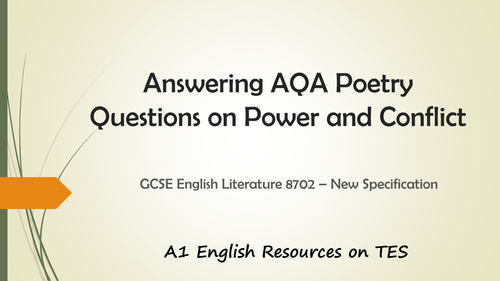











This resource features a set of TWELVE exam questions for 'Power and Conflict' poetry AND a 32-slide Powerpoint presentation AND supporting worksheets, showing students how to create an exam answer comparing ‘Remains’ by Simon Armitage with ‘Bayonet Charge’ by Ted Hughes.
These questions have been carefully designed to reflect the exact format and demands of the new AQA GCSE English Literature exam paper. They can be used as class activities, homework and for practice tests in the run-up to the exams.
The presentation is designed to help you prepare your class to answer a GCSE English Literature question on AQA Power and Conflict Poetry. It is NOT intended to teach students the poems themselves – students should already be familiar with the two poems used within. It has been carefully designed and created to help you guide your class through each part of the essay writing process. It examines each of the following elements: the AOs and the Mark Scheme, exam timing and weighting, essay structure, how to write an introduction, using ‘rough notes’ for planning, contents of the main body and how to write a conclusion. Most importantly, it features many extracts from the sample exam answer which are annotated to show the importance of using subject terminology, precise and judicious quotes and comparative links.
The worksheets included are:
1. Power and Conflict Sample Answers – this 800-word sample answer to the question is presented in two formats for your convenience. The first is a one-page A4 handout of the essay itself. The second is a two-page A4 handout with wider margins and more generous spacing – this allows ample space for annotation and highlighting, allowing students to completely break down the elements of the essay. I would suggest copying this onto an A3 sheet – I’ve used it very effectively with pairs of students using different colour markers to highlight the various AOs, the subject terminology, comparative terms, precise quotes etc.
2. Power and Conflict Sample Planning Grid –a one-page A4 handout which shows the students how to use ‘rough notes’ to plan and structure their essay.
4. Planning Grid Template –a one-page A4 handout featuring a blank Planning Grid which students can use to plan their own essays for any part of the GCSE English course.
5. Power and Conflict AOs –a one-page A4 handout which explains the AOs to students in a manner that is accessible and easy to understand. It eliminates any confusion about the Mark Scheme and shows students exactly what elements need to be included to gain maximum marks.
I hope these are helpful for you and instructive for your students – as always, I’d be delighted to hear any feedback you may have.
I will be adding lots more GCSE revision resources to my shop so please check back regularly!
These questions have been carefully designed to reflect the exact format and demands of the new AQA GCSE English Literature exam paper. They can be used as class activities, homework and for practice tests in the run-up to the exams.
The presentation is designed to help you prepare your class to answer a GCSE English Literature question on AQA Power and Conflict Poetry. It is NOT intended to teach students the poems themselves – students should already be familiar with the two poems used within. It has been carefully designed and created to help you guide your class through each part of the essay writing process. It examines each of the following elements: the AOs and the Mark Scheme, exam timing and weighting, essay structure, how to write an introduction, using ‘rough notes’ for planning, contents of the main body and how to write a conclusion. Most importantly, it features many extracts from the sample exam answer which are annotated to show the importance of using subject terminology, precise and judicious quotes and comparative links.
The worksheets included are:
1. Power and Conflict Sample Answers – this 800-word sample answer to the question is presented in two formats for your convenience. The first is a one-page A4 handout of the essay itself. The second is a two-page A4 handout with wider margins and more generous spacing – this allows ample space for annotation and highlighting, allowing students to completely break down the elements of the essay. I would suggest copying this onto an A3 sheet – I’ve used it very effectively with pairs of students using different colour markers to highlight the various AOs, the subject terminology, comparative terms, precise quotes etc.
2. Power and Conflict Sample Planning Grid –a one-page A4 handout which shows the students how to use ‘rough notes’ to plan and structure their essay.
4. Planning Grid Template –a one-page A4 handout featuring a blank Planning Grid which students can use to plan their own essays for any part of the GCSE English course.
5. Power and Conflict AOs –a one-page A4 handout which explains the AOs to students in a manner that is accessible and easy to understand. It eliminates any confusion about the Mark Scheme and shows students exactly what elements need to be included to gain maximum marks.
I hope these are helpful for you and instructive for your students – as always, I’d be delighted to hear any feedback you may have.
I will be adding lots more GCSE revision resources to my shop so please check back regularly!
Something went wrong, please try again later.
This resource hasn't been reviewed yet
To ensure quality for our reviews, only customers who have purchased this resource can review it
Report this resourceto let us know if it violates our terms and conditions.
Our customer service team will review your report and will be in touch.
£6.95